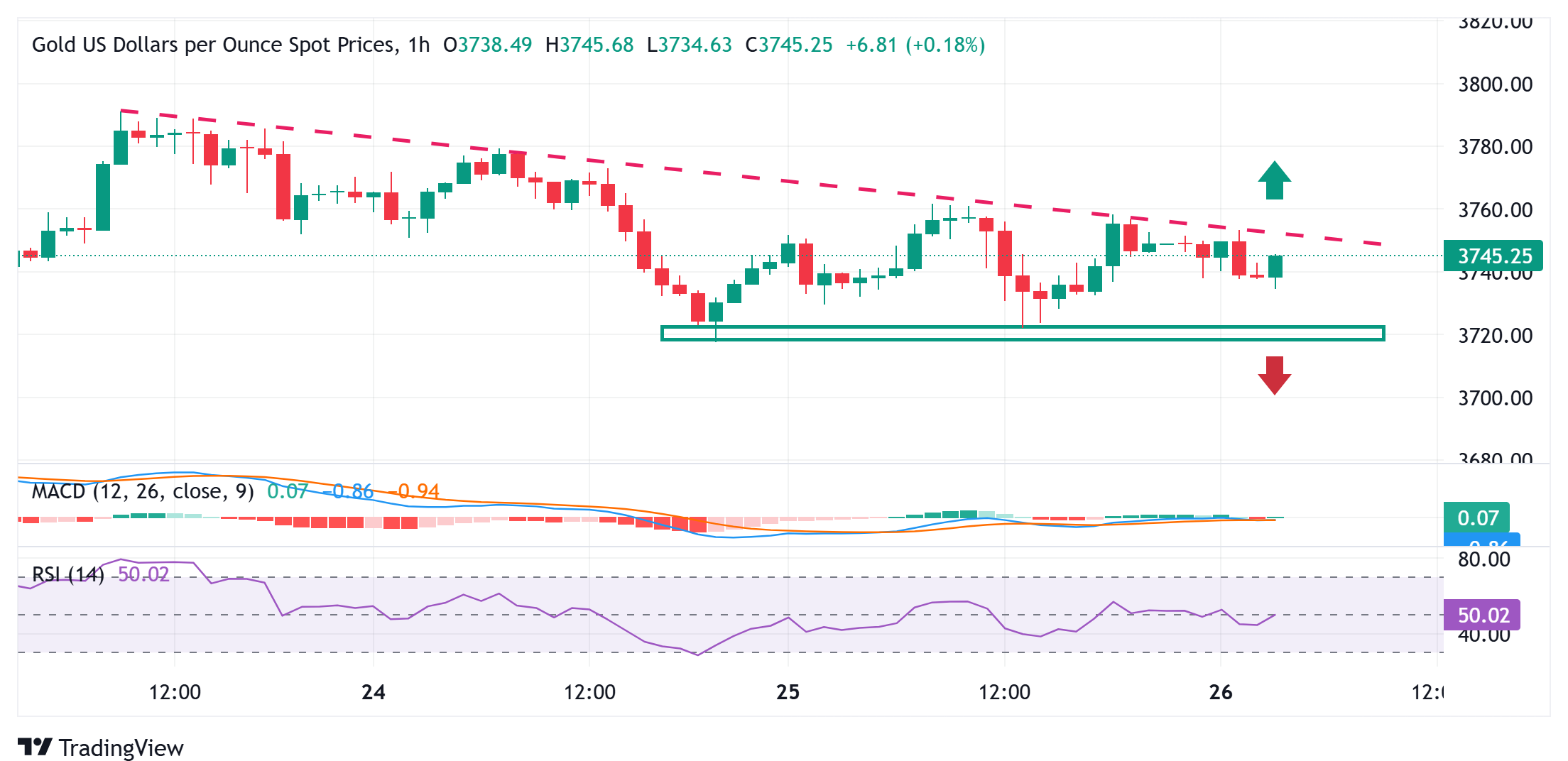Gold dips as Fed rate cut bets fade; lacks bearish conviction ahead of US PCE data

- Gold edges lower amid receding Fed rate cut bets, though the downside remains cushioned.
- Concerns about Trump’s tariffs and geopolitical risks continue to underpin the commodity.
- The USD pauses near a three-week top and further lends support ahead of the US PCE data.
Gold (XAU/USD) struggles to capitalize on the previous day's modest gains and attracts fresh sellers during the Asian session on Friday. The upbeat US macro data released on Thursday fueled uncertainty over the pace of interest rate cuts by the Federal Reserve (Fed), which helped the US Dollar (USD) to preserve its recent strong gains to a three-week high. This, in turn, is seen as a key factor acting as a headwind for the non-yielding yellow metal. The downside, however, is likely to remain cushioned as traders might opt to wait for the release of the US Personal Consumption Expenditure (PCE) Price Index before placing fresh directional bets around the commodity.
Meanwhile, traders still expect that the US central bank will lower borrowing costs again in October and December, which, in turn, is holding back the USD bulls from placing aggressive bets and offering some support to Gold. Furthermore, renewed concerns about the potential economic fallout from US President Donald Trump's new round of tariffs on a broad range of goods, along with rising geopolitical tensions, should help limit losses for the safe-haven precious metal. Hence, it will be prudent to wait for strong follow-through selling before positioning for an extension of the XAU/USD pair's pullback from the vicinity of the $3,800 mark, or the all-time peak.
Daily Digest Market Movers: Gold bulls seem reluctant amid mixed cues, ahead of critical US inflation data
- The US Bureau of Economic Analysis' (BEA) final estimate published on Thursday showed that the economy expanded at an annualized pace of 3.8% in the second quarter, significantly higher than the previously estimated growth of 3.3%. Moreover, the revision highlights a strong rebound from a 0.5% contraction recorded in the first quarter.
- Furthermore, the US Census Bureau reported that Durable Goods Orders rose by 2.9% month-over-month in August, reversing a revised 2.7% slump in July and better than market estimates of a 0.5% fall. Adding to this, US Initial Jobless Claims dropped to 218K for the week ending September 20 from the previous week’s 232K (revised from 231K).
- The strong data pointed to economic resilience despite headwinds stemming from US President Donald Trump's trade tariffs. In fact, Trump on Thursday announced a 100% tariff on imports of branded or patented pharmaceutical products, 25% levies on imports of all heavy-duty trucks, and 50% tariffs on kitchen cabinets starting from October 1.
- Federal Reserve Governor Stephen Miran told Fox Business on Thursday that there is no material evidence of tariff-driven inflation, but that seems to be holding up policymakers. The economy is more vulnerable to downside shocks because Fed policy is too tight and the policy is 200 basis points too restrictive, Miran added further.
- Separately, Chicago Fed President Austan Goolsbee noted that the job market seems to be cooling, but inflation is going up, and counting on inflation being transitory makes him uneasy. Goolsbee added that rates can go down a fair bit more if inflation heads toward 2%, but was wary of frontloading rate cuts, and that we must get inflation to 2%.
- Kansas City Fed President Jeffrey Schmid said that the decision to lower interest rates was appropriate as the recent data points to rising risks to the job market. Fed policy is slightly restrictive, which is the right place to be; inflation is still too high, and going forward, we will be data-dependent on monetary policy choices, Schmid noted further.
- Furthermore, San Francisco President Mary C. Daly made additional comments, saying that the impact of tariffs on inflation hasn't been as large as forecast. We are in a tradeoff space and need to balance risks. A little more rate cutting will be needed over time, though the Fed still needs to watch both sides of its mandate, Daly stated further.
- Nevertheless, the CME Group's FedWatch Tool indicated that traders are still pricing in an over 85% chance that the Fed will lower borrowing costs by 25 basis points in October, and odds for another rate cut in December stand at just over 60%. This keeps a lid on the recent US Dollar rally to a three-week high and could support the Gold price.
- Traders now look forward to the release of the US Personal Consumption Expenditure (PCE) Price Index, due later during the North American session. The core PCE Price Index is considered the Fed's preferred inflation gauge and might influence expectations about the future rate-cut path, which, in turn, will drive the USD and the non-yielding yellow metal.
Gold needs to find acceptance below $3,720-3,715 support to back the case for any further corrective fall

From a technical perspective, the XAU/USD pair has been facing some resistance near a downward-sloping trend line extending from the all-time peak touched earlier this week. The downside, however, remains cushioned near the $3,720-3,715 horizontal zone, which should now act as a key pivotal point for intraday traders. Sustained weakness below, leading to a subsequent break through the $3,700 mark, might prompt some technical selling and pave the way for an extension of this week's retracement slide from the record high. The subsequent downfall could drag the Gold price to the $3,650 intermediate support en route to the $3,610-$3,600 region.
Meanwhile, the aforementioned trend-line is currently pegged near the $3,753-3,754 area and should act as an immediate strong barrier for the Gold price. A sustained move beyond, however, might set the stage for a move towards challenging the all-time peak, around the $3,790 area touched on Tuesday. Some follow-through buying and acceptance above the $3,800 mark would be seen as a fresh trigger for the XAU/USD bulls, which, in turn, should pave the way for the resumption of a well-established uptrend witnessed over the past month or so.
Gold FAQs
Why do people invest in Gold?
Gold has played a key role in human’s history as it has been widely used as a store of value and medium of exchange. Currently, apart from its shine and usage for jewelry, the precious metal is widely seen as a safe-haven asset, meaning that it is considered a good investment during turbulent times. Gold is also widely seen as a hedge against inflation and against depreciating currencies as it doesn’t rely on any specific issuer or government.
Who buys the most Gold?
Central banks are the biggest Gold holders. In their aim to support their currencies in turbulent times, central banks tend to diversify their reserves and buy Gold to improve the perceived strength of the economy and the currency. High Gold reserves can be a source of trust for a country’s solvency. Central banks added 1,136 tonnes of Gold worth around $70 billion to their reserves in 2022, according to data from the World Gold Council. This is the highest yearly purchase since records began. Central banks from emerging economies such as China, India and Turkey are quickly increasing their Gold reserves.
How is Gold correlated with other assets?
Gold has an inverse correlation with the US Dollar and US Treasuries, which are both major reserve and safe-haven assets. When the Dollar depreciates, Gold tends to rise, enabling investors and central banks to diversify their assets in turbulent times. Gold is also inversely correlated with risk assets. A rally in the stock market tends to weaken Gold price, while sell-offs in riskier markets tend to favor the precious metal.
What does the price of Gold depend on?
The price can move due to a wide range of factors. Geopolitical instability or fears of a deep recession can quickly make Gold price escalate due to its safe-haven status. As a yield-less asset, Gold tends to rise with lower interest rates, while higher cost of money usually weighs down on the yellow metal. Still, most moves depend on how the US Dollar (USD) behaves as the asset is priced in dollars (XAU/USD). A strong Dollar tends to keep the price of Gold controlled, whereas a weaker Dollar is likely to push Gold prices up.







